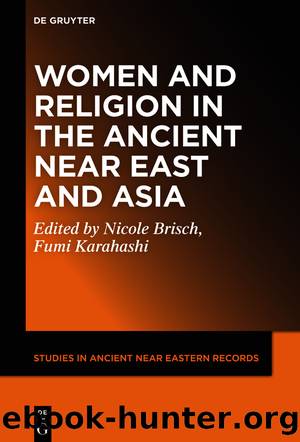Women and Religion in the Ancient Near East and Asia by Nicole Brisch Fumi Karahashi

Author:Nicole Brisch, Fumi Karahashi
Language: eng
Format: epub
Publisher: De Gruyter
Published: 2022-06-13T09:40:45.876000+00:00
The ruler raised his head high in the courtyard of the goddess from Sirara. He offered bread, poured cold water and went to NanÅ¡e to pray to her: âNanÅ¡e, mighty lady, lady of most precious (?) powers, lady who like Enlil determine fates, my NanÅ¡e, what you say is trustworthy and takes precedence. You are the interpreter of dreams among the gods, you are the lady of all the lands. Mother, my matter today is a dream.â6
Gudea refers to NanÅ¡e as a âwise dream-interpreter in her own rightâ (Cylinder A ii 1), but apparently, she was not to be approached directly. The second dream, which Gudea incubates during his construction work, he does not take to NanÅ¡e, but instead he performs extispicy on a white kid, presumably to validate that his dream indeed was a communication from Ningirsu. This time he understands the dream without the help of a dream-interpreter.
Presumably, it was a human ensi, who spoke the words of NanÅ¡e when she explained Gudeaâs first dream to him. In the Hymn to NanÅ¡e A, a human dream-interpreter takes part in the New Yearâs celebrations preparing silver cups for NanÅ¡e. It is unfortunately not certain, whether this person was male or female, it could well be a woman, but it might just as well be a man (Heimpel 1998â2001: 154). After the Ur III period NanÅ¡e all but vanishes. She makes rare appearances in learned texts, lexical lists, and rituals.
Ningirsu had promised Gudea both a sign and a pure star to indicate his wishes. Indeed, the first dream includes a vision of a young woman: âwho held a stylus of refined silver in her hand, who had placed it on a tablet with propitious stars and was consulting it, was in fact my sister Nisaba. She announced to you the holy star auguring the building of the houseâ (Cylinder A v 22-vi 2). This must be a reference to a form of astrology even if it probably reflects the selection of a propitious time according to the celestial clock, a mazel tov, rather than omen astrology in the form known from EnÅ«ma Anu Enlil and reports the Neo-Assyrian court astrologers. It could also simply be a reference to time keeping and the use of the fixed stars to realign the lunar calendar with the seasons. Nisabaâs relation to time keeping is evident from her epithet as the one who together with Suen counts the days.7 Keeping track of the calendar â and perhaps even of favorable times for beginning an undertaking â would be a natural skill for the âunsurpassed overseerâ (ugula nu-diri) directing the activities of the agricultural annual cycle.
Nisaba was the goddess of grain and the scribal arts, including knowledge of âheavenly starsâ (mul an). Despite her affinity with the configurations of the stars of the sky, she was not associated with divination of any sort. Somehow, one gets the impression of Nisaba as a strangely ethereal goddess â more of a concept than a goddess in the flesh (or whatever gods are made of).
Download
This site does not store any files on its server. We only index and link to content provided by other sites. Please contact the content providers to delete copyright contents if any and email us, we'll remove relevant links or contents immediately.
The Daily Stoic by Holiday Ryan & Hanselman Stephen(2713)
The Fate of Rome: Climate, Disease, and the End of an Empire (The Princeton History of the Ancient World) by Kyle Harper(2443)
People of the Earth: An Introduction to World Prehistory by Dr. Brian Fagan & Nadia Durrani(2352)
Ancient Worlds by Michael Scott(2107)
Babylon's Ark by Lawrence Anthony(2074)
Foreign Devils on the Silk Road: The Search for the Lost Treasures of Central Asia by Peter Hopkirk(2059)
India's Ancient Past by R.S. Sharma(1988)
MOSES THE EGYPTIAN by Jan Assmann(1977)
The Complete Dead Sea Scrolls in English (7th Edition) (Penguin Classics) by Geza Vermes(1845)
Lost Technologies of Ancient Egypt by Christopher Dunn(1803)
The Daily Stoic by Ryan Holiday & Stephen Hanselman(1780)
The Earth Chronicles Handbook by Zecharia Sitchin(1754)
24 Hours in Ancient Rome by Philip Matyszak(1685)
Alexander the Great by Philip Freeman(1656)
Aztec by Gary Jennings(1552)
The Nine Waves of Creation by Carl Johan Calleman(1523)
Curse Tablets and Binding Spells from the Ancient World by Gager John G.;(1514)
Before Atlantis by Frank Joseph(1487)
Earthmare: The Lost Book of Wars by Cergat(1472)
